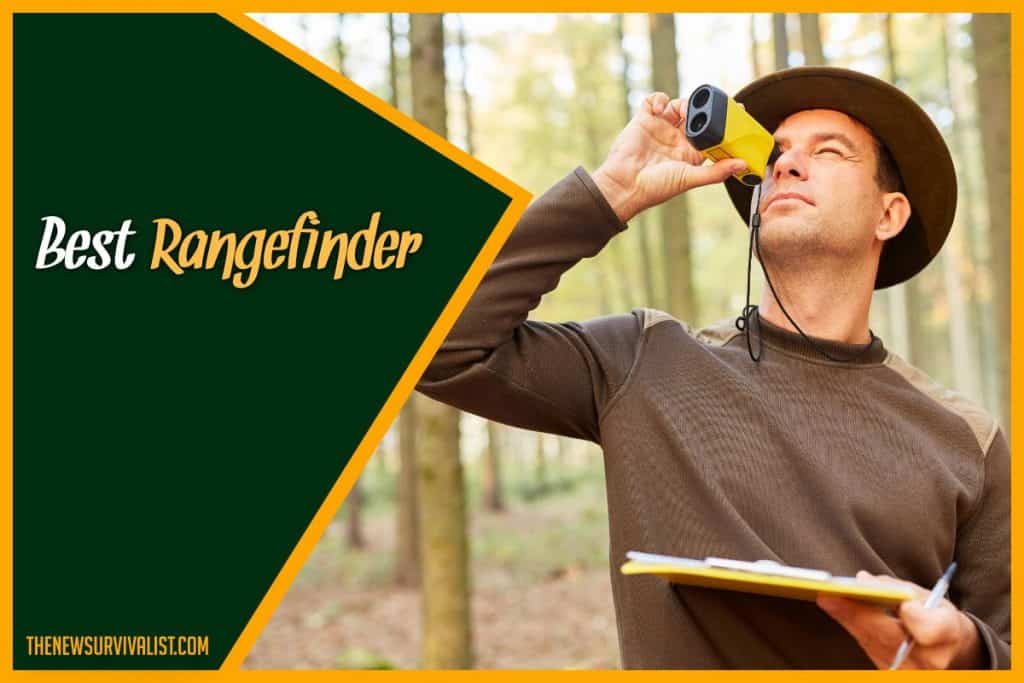Hunting with the best rangefinder might make the difference between numbing your butt all day and bagging that prized buck.
These versatile instrument can reduce the uncertainty of your shot and allow you to fill that gun tag and put meat in the cooler. Manufacturers have been customizing these devices for golfing, for archery, for hunting of course and more recently, even for photography.
However, finding the right rangefinder can be difficult. Not to mention that the price on these things can start from a paltry $100 and extend all the way to $14000.
How do you narrow down on the best rangefinder for your intended application without burning your fingers?
That’s where we chime in.
Here’s our recommendations of the best rangefinders for hunting in 2019.
#1 – Vortex Optics Ranger
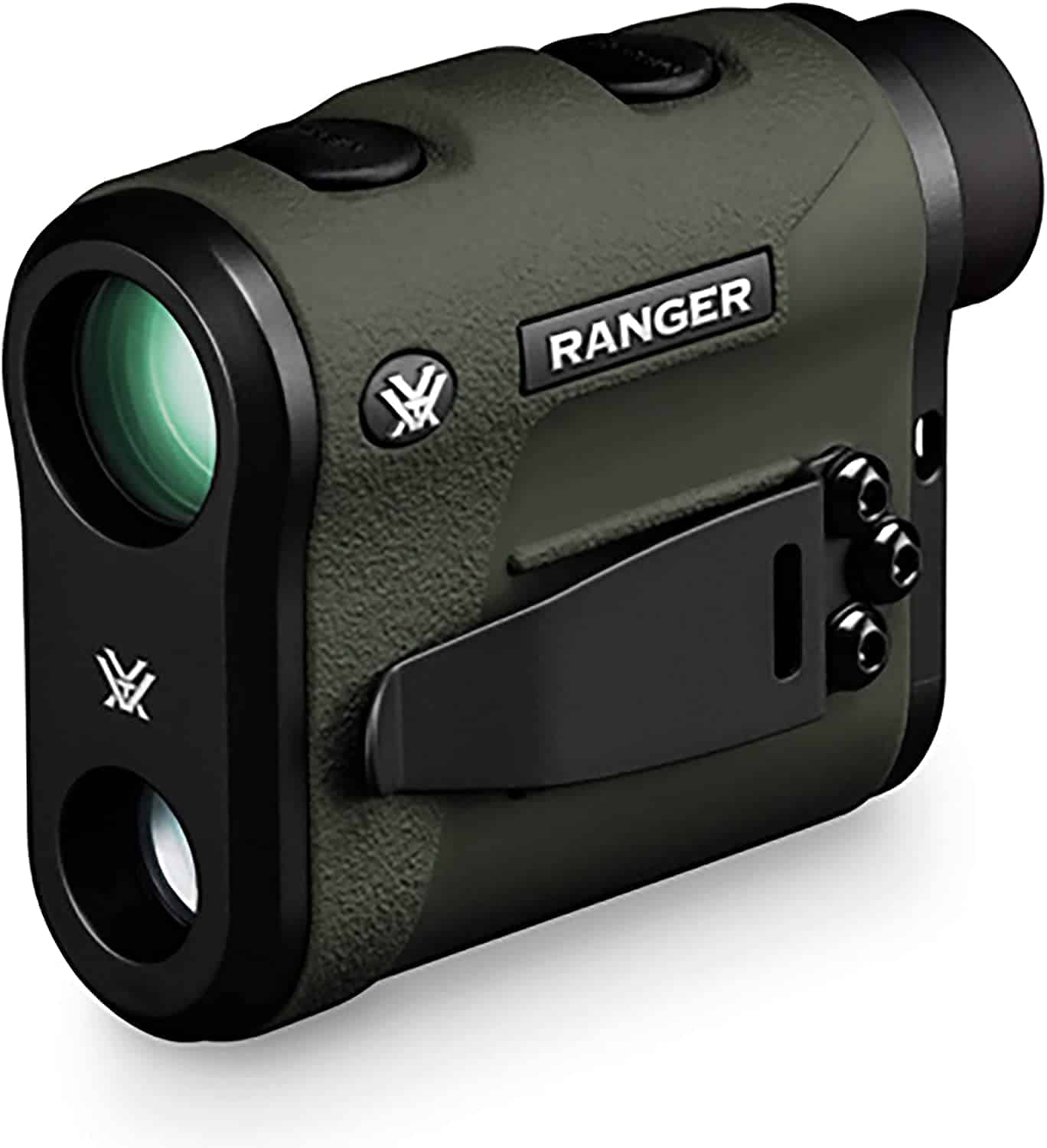
The Ranger is Vortex Optics’ flagship-killer that’s extremely popular among recreational rifle shooters as well as hunters.
Amazing optical quality, practical features and a streamlined user interface make this a great budget-priced option for anyone looking for a reliable rifle-oriented optic.
The 1300 is an extremely compact unit with a waterproof, rugged design that’s easy to grip and light enough to carry all day. It comes with a 22mm objective lens clubbed with 17mm of eye relief.
The fully multi-coated lenses provide excellent visual quality even at the max range, which is much more than what most people would shoot at.
The magnification is 6x and is clearly not the best feature of the rangefinder. But you get pin point accuracy to within -/+ 3 yards even at 1000 feet.
The max yardage is an impressive 1300 feet with 650 feet for deer.
You can select the standard mode that shows you the horizontally corrected distance, automatically compensating for any tiny angle adjustments.
Or you can opt for the Line of Sight mode for a truer range reading. The scan mode gives you a real time baseline figure as you pan across the landscape.
The only thing missing here is ballistic readings. But for a skilled hunter, that would never be a deal breaker.
Overall, we couldn’t be more impressed with the Vortex Ranger 1300. It is an extremely well rounded unit that offers plenty for the price tag that it is being sold at.
Pros
- Rugged, compact unit with rubberized coating
- 1300 yards max yardage, 650 for deer
- Scan mode automatically gives you a baseline as you scan the landscape
- Accuracy to within -/+ 3 yards at 1000 feet
- Minimal features but very easy to use
- Multi coated optics
Cons
- Lacks some of the more advanced features that bow hunters seek. But at this price point, it is a steal.
#2 – Sig Sauer KILO1200
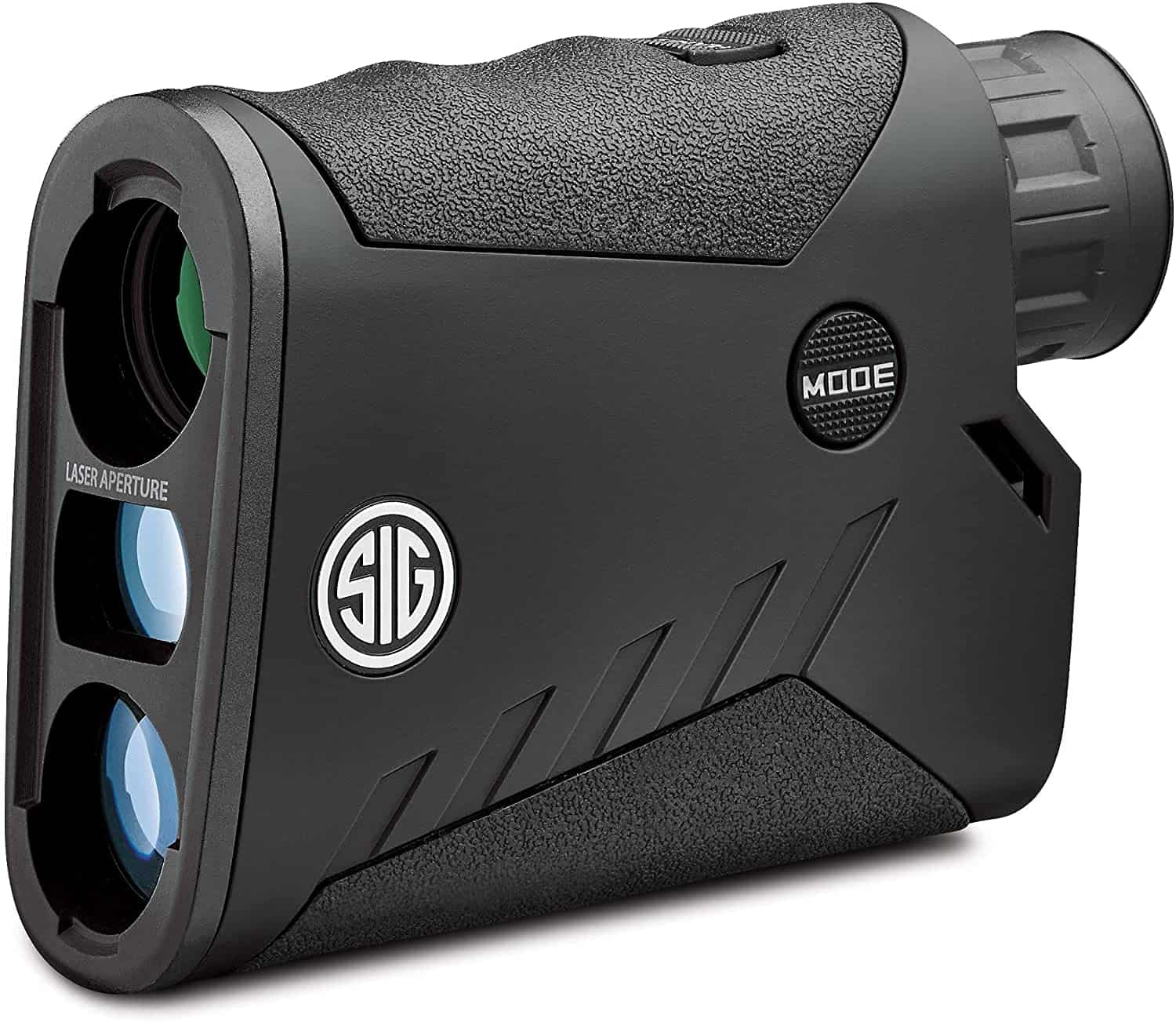
The Kilo 1200 is one of the latest additions to Sig Sauer’s constantly expanding product range in the firearms space.
And it is a hell of an addition, we’ll give you that.
This tiny laser rangefinder boasts of a max yardage of up to 700 yards for game and trees. And up to 1600, if you are shooting at a reflective surface.
Yet, it is compact enough to carry without straining your neck (lanyard) as it weighs just 5 oz. with the battery.
With the controls centered around just two buttons, it is also one of the easiest laser rangefinders to use.
Sig Sauer’s trademark Lightwave Digital Signal Processing engine runs algorithms at the rate of knots and gives you fast and accurate readings in real time.
With a refresh rate of 4 times per second, false positives are minimal.
For angle compensation while shooting uphill or downhill, there are two modes to choose from.
There’s LOS (Line-of-Sight) which displays both straight line distance as well as angle of inclination to the target. If you are using a ballistics calculator, then this setting will be very useful for long range hunting.
Then there’s AMR (Angle Modified Range), which is the default setting that automatically calculates the distance from the projectile to the target with an accuracy of -/+ 1/2 yard at 500 yards.
The LCD display gives you amazing clarity in low light.
Pros
- Compact, lightweight unit
- 4x magnification
- Extremely accurate for up to 1000 yards
- Max yardage of 1600 for reflective surfaces
- Sig Sauer’s trademark Lightwave DSP engine
- Real time scans
- Accurate to -/+ ½ yard up to 500 yards. 1 yard at 1000 yards
Cons
- No brightness adjustment in the LCD display. No OLED display either.
#3 – Nikon 16224 Arrow ID 3000
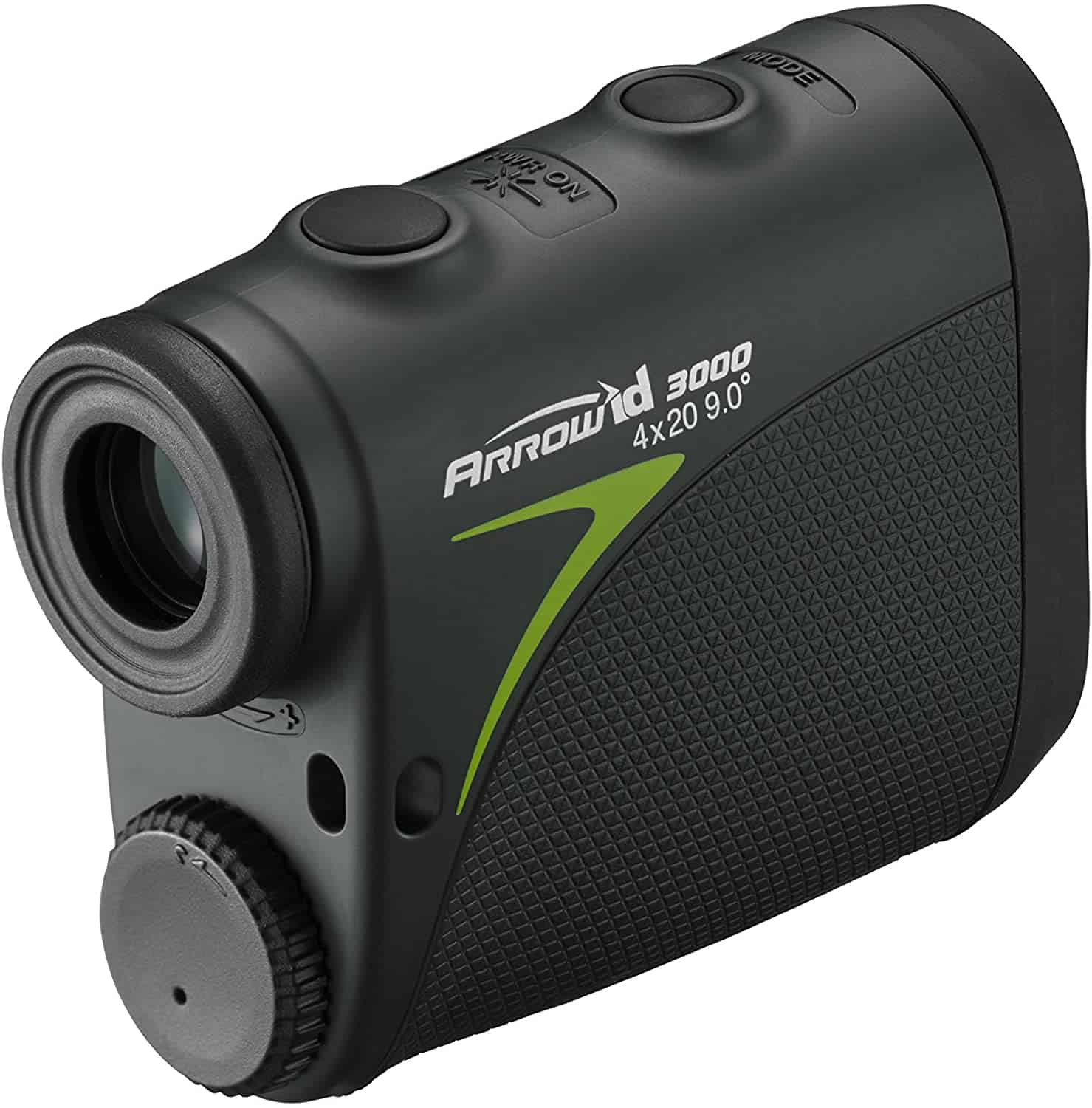
With the Arrow ID 3000, Nikon has created a dedicated optic for the bowhunting crowd, which otherwise has to settle at multipurpose laser rangefinders.
This one comes with a maximum yardage of just 550 yards which is perfect for bowhunting.
It comes with multilayer coated optics with 4x magnification and a 20mm objective lens with an impressive eye relief of 20.3mm.
Weighing just 4.8 oz., this is perfect for all-day hunts and the ergonomic design gives you a firm grip in all weather conditions.
The features are pretty basic. There’s a scan mode for real time values and ranges, a target priority setting that can be used to target the closest or the farthest targets. This is based on Nikon’s Tru-Target Tech.
The screen display is uncluttered. Everything is clear and easy to spot and low light visibility is excellent.
There’s no display brightness adjustment, which is a tiny quibble in budget-priced rangefinders.
The standout feature is Nikon’s ID (Incline/Decline) Technology, which can be very useful if you hunt out of a stand. This compensates for the elevation giving you 100% accuracy on the horizontal range.
Overall, if you are into bowhunting and are seeking the best rangefinder for the job, look no further. In fact, this might be a decent pick for golfers as well. Just that it lacks more advanced features, like pin lock.
Pros
- Compact unit
- LCD display with uncluttered interface
- Nikon’s ID technology for hunters using treestands
- Extremely clear optical quality
- Decent low light visibility
- 4x magnification
- Wide field of view
- 3 mm eye relief which is excellent
Cons
- Doesn’t offer ballistic calculations for rifle hunters
#4 – Wosports Hunting Range Finder
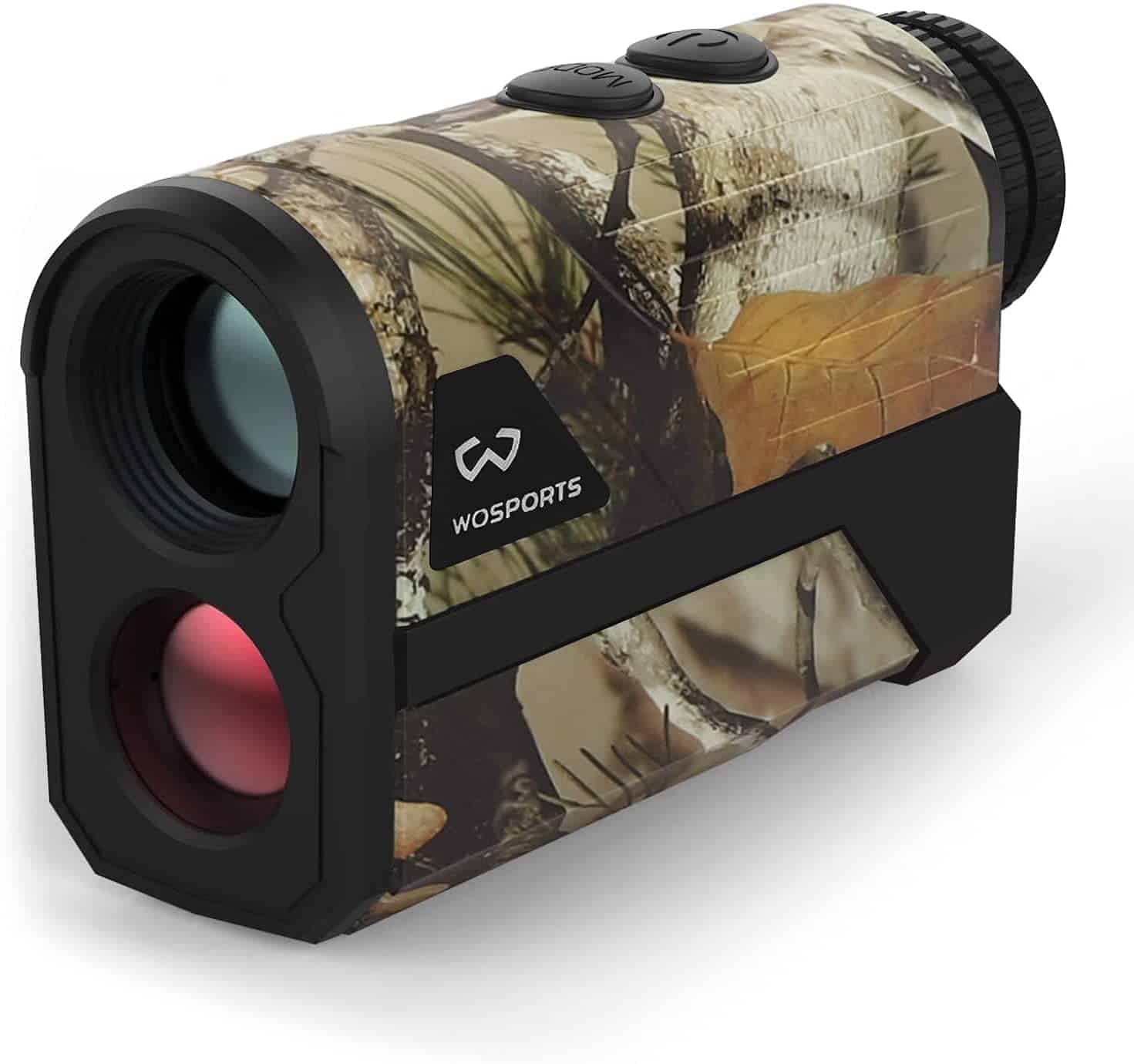
For a budget-priced multipurpose rangefinder, the Wosports Hunting range finder certainly does pack a punch with its features and performance.
While it is advertised as a hunting range finder, it has three modes that are better suited for golfers.
There’s range, which lets you scan/pan the landscape for real time distance, the pin seeker mode which locks on to the flag stick (or a target) and vibrates when it does, there’s pin seeker with slope which automatically compensates for the incline, decline and gives you the horizontal distance and lastly, a slightly obscure mode which calculates the speed of a moving target in kms/hour.
It has a 25mm objective lens with 6x magnification. The fully multicoated lens gives you amazing clarity even in less-than-ideal conditions.
The unit is lightweight and has a tactical coating to boot with a rubberized grip. Also comes with a carrying case that has an annoying Velcro. If you are using this to hunt at short distances, you’d have to get rid of that.
After 30 seconds of inactivity, the unit auto shuts off conserving battery.
Despite a few tiny niggles, this is a very useful unit for golfers. Don’t forget that it costs less than half of some of the higher priced units with very similar features.
Pros
- Multipurpose rangefinder
- Fully multi coated lenses
- Tactical coating, rubberized grip
- 25mm optical lens
- 6x magnification
- 4 modes to choose from
- 3 golfing modes
- Shuts off after 30 seconds of inactivity
Cons
- Lacks advanced features
- Max yardage is 650 yards only
#5 – LaserWorks S7 Rangefinder
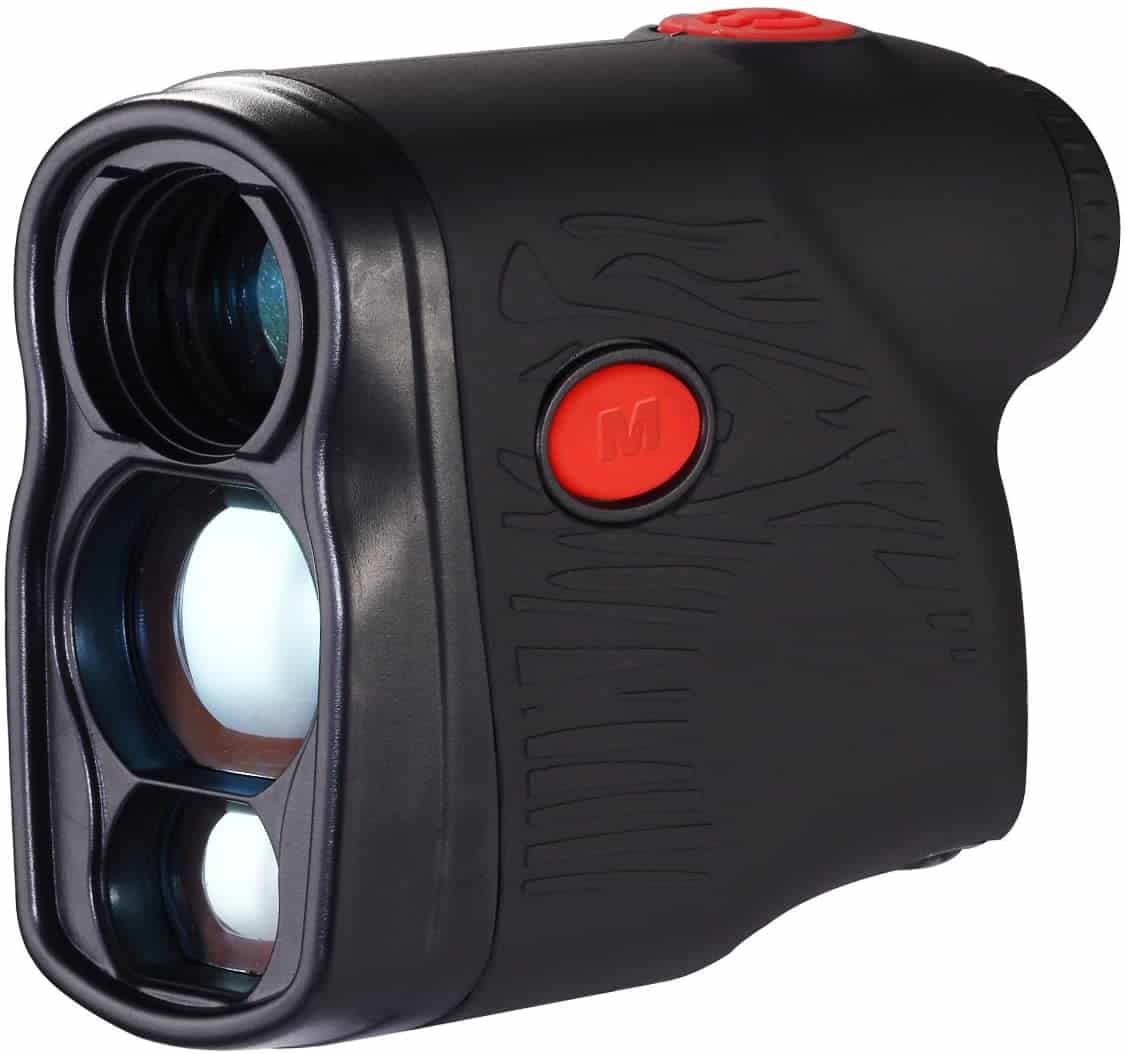
Under the unassuming exterior, which looks obsolete if you compare it with fancier, pricier models, the LaserWorks S7 is an amazing laser rangefinder crammed with practical features.
Some of them, are best-in-class.
Like accuracy to 0.1 yard at 150 yards or more, and an anti-fog mode which lets you get accurate readings in inclement weather.
It has a max yardage of 1200 meters with up to 1600 yards for a reflective surface, which is incredible at this price point.
That’s not all.
There are multiple modes, like the dedicated hunting mode which gives you horizontal distance with angle compensation, the antifog mode which we just mentioned, the pin lock mode for golf, the slope compensation distance for golf, pin scan mode and line of sight mode for hunting from an elevated tree stand.
Toggling between modes and measuring distances is made easier as the buttons are not placed next to each other.
The S7 features a 21mm objective lens with 6x magnification. It is completely waterproof and weighs just 7 oz.
The fully multicoated lens offers clear visibility. Maybe a tad fuzzy near the edges. But nothing that affects the performance or the accuracy of the rangefinder.
Lastly, the S7 shuts down after 15 seconds of inactivity.
Overall, the S7 boasts of enough features to appeal both rifle hunters and bow hunters. Golfers in particular will find this model very appealing with the long yardage and dedicated golf modes.
Pros
- Compact unit with waterproof covering
- Weighs just 7 oz.
- 1200 yards max yardage
- Multiple modes for hunting and golfing
- 21mm objective lens with 6x magnification
- Anti-fog mode for use during inclement weather
- Shuts down after 15 seconds of inactivity
Cons
- A little fuzzy at the edges
- LCD display is not ideal for very low light situations
How to Select the Best Rangefinder
Irrespective of whether you are looking for boasting rights at a weekend round of golf, or you are trying to connect an arrow to a moving prey that’s 600 yards away, the best laser rangefinder will maximize your chances of success.
You will exercise more control over variables like angles, weather and obstacles, all of which can determine the accuracy of your shot, bullet or arrow.
However, Rangefinders have evolved considerably in the last few years and have gone past the use of beam divergence as a key selling point.
Here are a few other important factors to consider when you look for one of these versatile units to tag along on your hunt.
#1 – The intended use
Look for rangefinders that have the best features that you seek for your intended application.
Rifle hunting rangefinders for example, are second priority rangefinders that will often ignore the objects in the direct line of view and read the ones at a distance. Because that’s usually where the deer are. Or it may be that the hunter is positioned behind a blind.
Golf rangefinders on the other hand are first priority devices that will read the flag at 100 yards and lock on to it, conveniently ignoring the trees behind the flag. That’s because there are usually very few obstacles between you and the flag.
Then there are multipurpose devices which try to give you the best of both worlds.
For example, the Vortex Optics Ranger 1300 is best suited for rifle shooting and the Nikon Arrow ID 3000 is cut out for bowhunting.
But the LaserWorks S7 is a multipurpose rangefinder that can be used for both these applications.
However, these devcies usually have a few tradeoffs and are preferred by beginners looking for an all-purpose tool. It’s always better to pick one that’s designed specifically for your intended use.
#2 – Distance
Maximum readable distance has replaced beam divergence as the key selling point for rangefinders.
However, these numbers can mislead an inexperienced buyer into believing that they can range a moving animal at the stated distance.
For example, a rangefinder may have a maximum yardage of 1600 yards. But that’s in ideal conditions for a highly reflective surface.
If there’s rain or mist, or if the object is darker or smaller, then the yardage will decrease considerably.
For deer, always consider the yardage to be less than half of the max stated distance.
So if you typically hunt deer at 500 yards, look for a rangefinder that has a max of at least 1200 yards.
#3 – Low light visibility/ Reticle
If you are using the rangefinder for hunting, then conditions will seldom be perfect.
You might use it at the crack of dawn, just before sunset, or at any other time to hunt for game, and the visibility of the reticle will be a key factor in determining how easy or difficult it is to read the information on the screen.
While this is subjective, most people tend to prefer a black or red reticle with decent low light visibility.
An LED, backlit display is undoubtedly better. But it’s also pricey.
#4 – Magnification
Magnification on budget-priced rangefinders can extend from 4x to 7x.
However, more is not necessarily better as magnification does not make it easier to range distant objects.
In fact, the magnification is one of the last variables that we would base our selection on.
#5 – Modes
Different manufacturers offer a variety of modes that you can toggle through. Some of these, like the scan mode which allows you to scan the landscape while displaying constantly updated readings in real time, are a must have.
Whereas ones like horizontal range mode, are rarely used, albeit still useful.
Rather than having a whole bunch of numbers on the screen which you rarely use, it’s better to have a simple uncluttered interface with only the essentials.
So rather than getting swayed with bells and whistles, look for what really matters.
#6 – Construction
Last but not the least, look at the size and weight of the unit. Is it durable? Weather resistant?
Is it IP rated for water exposure? Can it survive if you accidentally drop it in a pond or a rivulet?
A rubberized grip is easier to grab in all kinds of weather.
Closing Thoughts
To give you a refresher, our #1 pick is the Vortex Optics Ranger 1300, a versatile rifle shooting rangefinder that has enough features to impress even the most discerning buyer.
Hunters will also love the quick refresh rates on the Sig Sauer Kilo 1200, which is a mighty impressive unit for the price.
The Wosports Hunting Range Finder is our pick of the lot for golfers. As is the LaserWorks S7, which has a very versatile feature list.
If you are into bowhunting, you will find that the Nikon Arrow 3000 ticks all the right boxes.
We hope that you can find the best rangefinder for your intended use in this list. Until next time, adios!

